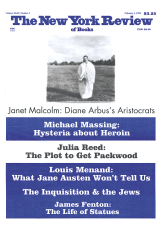In response to:
Beethoven's Triumph from the September 21, 1995 issue
To the Editors:
I am sorry to say it, but Charles Rosen’s reading of Beethoven’s indication for the second fugue in op. 110 “L’istesso tempo della Fuga—poi a poi di nuovo vivente—nach und nach wieder auflebend” remains a misreading [“Beethoven’s Triumph,” NYR, September 21, 1995, and “Letters,” NYR, November 16, 1995]. If Beethoven would have meant to call for “a gradual acceleration,” which according to Rosen he did, he would have made it clear in different wording: as “poi a poi sempre più allegro” (op. 111), or, perhaps, as “poi a poi più vivente.” The key word in his indication is “di nuovo” (“wieder”). The piece gets back to life, rather than adding further life.
“Gradually reviving” is a psychological clue, borne out by everything that happens in the music. The performer should not hesitate to react to it, and add some dynamics within the una corda range.
Alfred Brendel
London, England
Charles Rosen replies:
It is absurd to insist that “the same tempo as the fugue—little by little getting back to life again” cannot be read as a demand for a slight and gradual quickening of the tempo, particularly since the page in question involves transforming the main theme, played twice as slow, back eventually into the original tempo. Alfred Brendel’s reading is the traditional one, and I do not foolishly claim that if Beethoven had wanted his indication to mean an increase in dynamics, he ought to have specified that more clearly by writing “poi a poi più forte.”
Any decision has finally to be made by a consideration of the tempo relationships of the whole work, but I think that adding too many dynamic accents to Beethoven’s twenty-four bars of soft pedal (with no other dynamic indications at all) would forfeit the simplicity that Proust’s grandmother justly claimed was the way to play a Beethoven sonata, as well as the way to receive visitors and prepare a steak with potatoes.
This Issue
February 1, 1996



